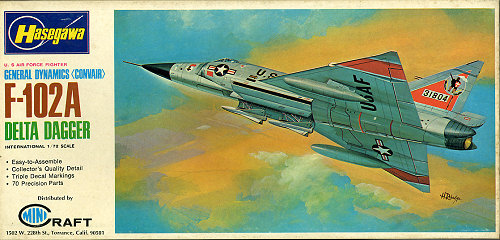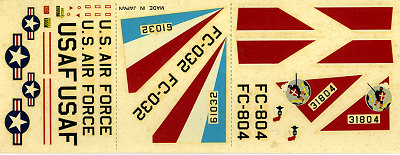
| KIT: | Hasegawa 1/72 F-102A Delta Dagger |
| KIT #: | JS-047 |
| PRICE: | $2.25 according to the box, but that was 30 plus years ago. |
| DECALS: | Two Options |
| REVIEWER: | Scott Van Aken |
| NOTES: | One of Hasegawa's older kits |

| HISTORY |
The F-102 was developed from the XF-92A delta wing research aircraft of the late 1940s. The Air Force took a new approach in putting out the request for proposals for an operational interceptor, considering both the aircraft and armament together in what became known as a "weapon system". The RFP for Project MX-1554 went out 18 June 1950, and in January 1951 six manufacturers responded, of which Convair, Lockheed and Republic were chosen to proceed with design. Three of these projects were too expensive, and in November, only Convair was allowed to continue with its Model 8-80, an interim project using the less-powerful Westinghouse J40 turbojet in lieu of the Wright J67 which was still in development.
The YF-102 made its first flight on 24 October 1953, but was lost in an accident nine days later. The second aircraft flew on 11 January 1954, confirming a dismal performance: Approximately 812 mph, while supersonic, it was far below the requirements. The problem was solved by the use of the area rule, which entailed narrowing the aircraft down in the mid-section, moving the cockpit and intakes back further, blending the outer contours of the intake duct, lengthening the nose and adding two fairings on either side of the engine nozzle, resulting in the new "'YF-102A design'". The new design was more than twice as fast as the non-area ruled design. The "'YF-102A'", however was not exactly the same as the production F-102A design in that its nose was considerably longer than the "'F-102A.'"
Somewhere along the way, the Wright J-67 was cancelled, and the J-40 was replaced with a Pratt & Whitney J-57.
The production F-102A had the Hughes MG-3 fire control system, later upgraded in service to the MG-10. It had a three-segment internal weapons bay under the fuselage for air-to-air missiles. Initial armament was three pairs of GAR-1 Falcon missiles, a mix of infrared and semi-active radar homing. The doors of the two forward bays each had tubes for 12 x 2.75 in FFAR rockets (for a total of 24). The F-102 was later upgraded to allow the carriage of an GAR-11 Nuclear Falcon missiles in the center bay. The larger size of this weapon required redesigned center bay doors with no rocket tubes. Plans were considered to fit the MB-1 Genie nuclear rocket to the design, but it was never adopted.
Because of the changes that had to be made in redesigning the aircraft with the area rule in mind, the ambitious plan to produce the production aircraft on the prototype tooling had to be abandoned; two-thirds of the 60,000+ pieces of tooling had to be scrapped or heavily modified.
To train F-102A pilots, 111 TF-102A trainers were developed. The aircraft was fitted with a side-by-side cockpit to facilitate ease of pilot training. This required a redesign of the cockpit and nose incorporating a set of vortex generators on the top of the cockpit to prevent flow separation under certain circumstances, and repositioning of the intake ducts. Despite the many changes, the aircraft was combat-capable, although this variant was predictably slower, only reaching subsonic speeds in level flight.
The F-102's direct successor was the related F-106 Delta Dart, which was originally designated YF-102B. The design underwent so many aerodynamic changes including a larger J-75 turbojet and a variable-geometry inlet design that it essentially became an entirely new plane.
| THE KIT |
 The F-102A was part of what many call the initial batch of Hasegawa kits. These are kits that were produced with raised panel lines, thick plastic, nearly non-existent interiors and lacking detail in wheel wells, and other fine parts. While they are not bad kits, they are certainly not up to modern standards. However, like many of the Century Series aircraft produced by Hasegawa in this scale (like the F-106 and F-101), this nearly 40 year old design is your lone choice if you wish to model this aircraft in this scale.
The F-102A was part of what many call the initial batch of Hasegawa kits. These are kits that were produced with raised panel lines, thick plastic, nearly non-existent interiors and lacking detail in wheel wells, and other fine parts. While they are not bad kits, they are certainly not up to modern standards. However, like many of the Century Series aircraft produced by Hasegawa in this scale (like the F-106 and F-101), this nearly 40 year old design is your lone choice if you wish to model this aircraft in this scale.
For many, many years, Minicraft imported Hasegawa kits, often modifying the boxes to read in English and including a set of English instructions. Generally, the kits were just as they were done in Japan and came with Japanese decals. Later Minicraft boxings in the 80s added Microscale produced decals, often with other markings options.
As mentioned in the opening paragraph, these older Hasegawa kits are a far cry from their modern counterparts. One gets a simple tub with generic seat and pilot, a rather poorly fitting one-piece canopy, a weapons bay that can only really be successfully built in the open position, a pair of drop tanks, Falcon missiles that are best replaced from an aftermarket set, and some rather spindly and plain landing gear and wheels. The wings are also quite thick and there is no trunking for the intakes.
In general, a kit of the late 1960s and early 1970s. Most of us have built this one and its brethern and know that a replacement is sorely needed.
 The kit's instructions have a parts breakdown, four rather simple construction steps along with a history and painting diagram on the other side of the sheet. Markings are provided for two aircraft. One is the box art plane from the 68th FIS based at Itazuke AB in Japan, and the other with the 32nd FIS based in the Netherlands. Actually, the instructions never really tell you what color to paint the overall aircraft, but these planes were either aluminum paint or ADC Grey. There are red band decals for the 68th FIS aircraft. As you can imagine, the years have not been too kind to the decals, though they could be salvaged if one was so inclined to try.
The kit's instructions have a parts breakdown, four rather simple construction steps along with a history and painting diagram on the other side of the sheet. Markings are provided for two aircraft. One is the box art plane from the 68th FIS based at Itazuke AB in Japan, and the other with the 32nd FIS based in the Netherlands. Actually, the instructions never really tell you what color to paint the overall aircraft, but these planes were either aluminum paint or ADC Grey. There are red band decals for the 68th FIS aircraft. As you can imagine, the years have not been too kind to the decals, though they could be salvaged if one was so inclined to try.
| CONCLUSIONS |
So there you have it. An old kit by anyone's standards, but one that can be built into a very nice model and one that is also in need of modern tooling. I should mention that Aeroclub does/did a single casting closed weapons bay door, so that will take care of that situation should you be so inclined.
May 2007
Thanks to me for this one.
If you would like your product reviewed fairly and quickly by asite that has over 350,000 visitors a month, please contactme or see other details in the